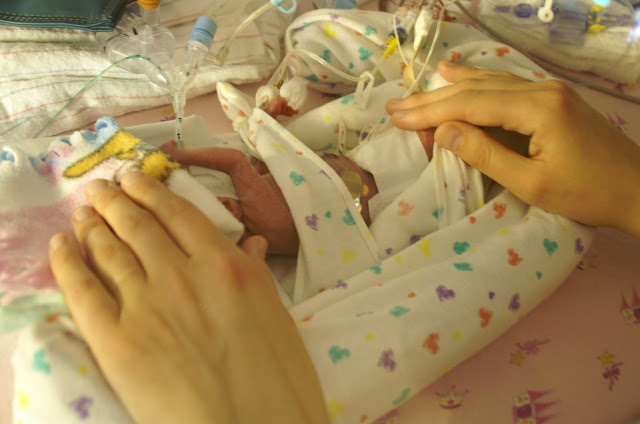Following the Thursday scare, we really are amazed at how well Gracie Lou is doing.
Sarita, Jonelle and I went to the hospital last night and spent a couple of hours with Gracie Lou and her nurses. Diane, her day nurse--normally on-duty from 7 am to 7 pm--was still there at quarter to 8. She gave us a picture she had taken earlier in the day of Dave and little Gracie Lou.
None of us had ever seen her outside of her incubator. But Dave was there, apparently, when they were doing some major reorganization. . . .
"How's she doing with her weight?" asked Sarita.
"She is 570 grams!"
I think that is pretty amazing. She was born last Friday at 440 grams. On Saturday, she went up to 470. Sunday, she was back down to 410. Since then, she has been on a steady rise. 570 grams marks a 30% increase in body weight in the course of a week.
Of course, she started out at half the weight she should have been for her age. So she still has a lot of catching up to do. But it's nice to know that she's gaining weight.
Here day nurse Diane is showing her photos to Sarita and Jonelle:
Meanwhile, just around the corner, the respiratory therapist and night nurse, Maegan, were turning Gracie Lou around.
Lying on her side as she had been, GL's lungs were developing at different rates. They wanted to give the other lung a better chance to catch up:
Poor kid! Being jostled and [wo]man-handled at every turn: poke, prod, yank, nudge, pull this cord, shift that
tube . . .
The rearrangement went on for, I would guess, five
minutes. . . .
. . . And I winced all the way through. Gracie Lou, however, seemed to take it all in stride . . .
Of course, her blood oxygen plummeted briefly. I didn't see it, but Jonelle said she saw it fall to 40 before bouncing back.
Gracie Lou has been doing amazingly well. Thursday, they had her on 100% oxygen and, as I reported, the doctors seriously questioned whether she would make it.
By mid-morning on Friday, she had been quite stable all night and they were able to wean her back to only 40% oxygen and her numbers continued to look good. But by the time we got in last night--what with all the moving and jostling, her number weren't looking so good, and she was up to 92% oxygen feed. . . .
"What's going on with her oxygen levels?" we asked.
The staff explained: Every time something upsets Gracie Lou, her body demands more oxygen. The fact that she is trying to grow so fast:
that requires more oxygen. Every time they adjust the oxygen input, her body has to acclimatize to the change. And while it is acclimatizing, the percentages of oxygen in the blood can fall. --Kind of like what happens to people who normally live at sea level and then come to visit Denver (at 5,300 ft above sea level). The air is relatively thin(ner) here, and their bodies need time to adjust. They find they are winded easily. They may suffer headaches. They need extra fluids.
So it is for micro-preemies like Gracie Lou. Their bodies need time to adjust.
And so it was with Gracie Lou. After a few minutes, her blood oxygen levels slowly rose to normal (or near-normal, anyway!).
At some point, after the rearranging had been going on for some time, I noticed Gracie Lou's left ear seemed rather deformed:
"What's going on with her ear?" I asked.
"Oh, at this stage, babies' ears lack the cartilage to hold their structure," said Maegan. And she gently flapped the ear back in place:
Ahh! Much better!
Then it was time to put in some Momma scent cloths--cloths that Momma has kept close to her body "simply" to absorb her scent so Baby Gracie Lou can enjoy the
fragrance. . . .
"Oh! Look at that! She has opened her eyes!"
One of my readers encouraged us to check out
Kangaroo Mother Care--a "method" by which newborns are given
maximal skin-to-skin contact with their mothers (and fathers!) pretty much from the moment of birth. Mentioning this kind of information and opportunity (much less pushing for it) can become highly emotional and controversial in the midst of ongoing medical care.
Despite the risks, I thought I would broach the topic gently with Jonelle: "Have you heard of
Kangaroo . . . ?"
I didn't even get the question out, and Jonelle said, "'Kangaroo Care'? Yes! We are planning to do that the moment they take the second line out of her belly."
"You mean the hospital is aware of Kangaroo Care?"
"Yes! . . ."
We asked the staff when Gracie Lou would get the line out of her belly.
"Probably next week," said our contact. "Y'know, we have it in her primarily so she doesn't have to be poked so much to get blood samples.
. . . She probably had five or six samples drawn today. And that's a lot of poking!"
Without the benefit of full body-to-body skin contact, we have been left with the next best option: as much gentle holding as possible. And so it was time for Jonelle to get her hands on the little one:
Items for prayer:
- That Gracie Lou's lungs will continue to strengthen.
- That the nursing staff will be able to continue to wean her off of the oxygen and the nitric oxide (used for vasodilation) that they have been feeding her in order to keep her blood gases properly balanced.
At this time, we were told, these really are the two key points for prayer.
Thank you!



























































